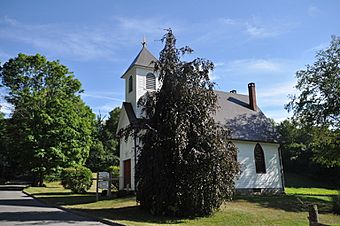Merryall Union Evangelical Society Chapel facts for kids
Quick facts for kids |
|
|
Merryall Union Evangelical Society Chapel
|
|
 |
|
| Location | Chapel Hill Rd., New Milford, Connecticut |
|---|---|
| Area | 0.1 acres (0.040 ha) |
| Built | 1890 |
| Built by | Soule, Tourney & Co.; Et al. |
| Architectural style | Gothic |
| NRHP reference No. | 86001240 |
| Added to NRHP | June 5, 1986 |
The Merryall Union Evangelical Society Chapel is a historic church building. It is also known as Merryall Union Chapel. This special building is located on Chapel Hill Road in the Lower Merryall area of New Milford, Connecticut. It was built in 1890. The chapel is a wonderful example of Carpenter Gothic architecture in the town. Today, it is used during the summer for church services. Different ministers lead these services. The chapel also hosts weddings and other private events. It was added to the National Register of Historic Places in 1986.
About the Merryall Chapel
What the Chapel Looks Like
The Merryall Chapel is in a quiet, countryside area. It is about 4 miles (6.4 km) north of New Milford's town center. The chapel is a single-story building. It is made of wood and has a steeply sloped roof. The outside walls are covered with clapboard siding.
A square tower stands out from the front of the building. This tower has a pointed roof and a decorative top. The main entrance is at the bottom of this tower. It has a pointed arch design above it. The side walls of the chapel have windows with pointed arches. Inside, the chapel has a Victorian style. It has special chairs for people to sit on. There is also a raised area at the back. This area serves as the altar. It has velvet armchairs and a couch.
How the Chapel Started
The Merryall Union Evangelical Association was formed in 1884. Its main goal was to provide Sunday School classes. These classes were for children in the local area. The chapel you see today grew from that group. The association wanted to offer regular church services. This was helpful for local people. Otherwise, they would have had to travel to the town center. That journey could sometimes be difficult.
Ministers who traveled or came from other churches often led the services. These services were usually open to all Christian faiths. Around 1900, a local sewing club began to take care of the building. Services were regularly held during the summer months. This brought in people who lived in the area during the summer. In the 1970s, a new non-profit group was created. This group now helps to keep the building well-maintained.
See Also



